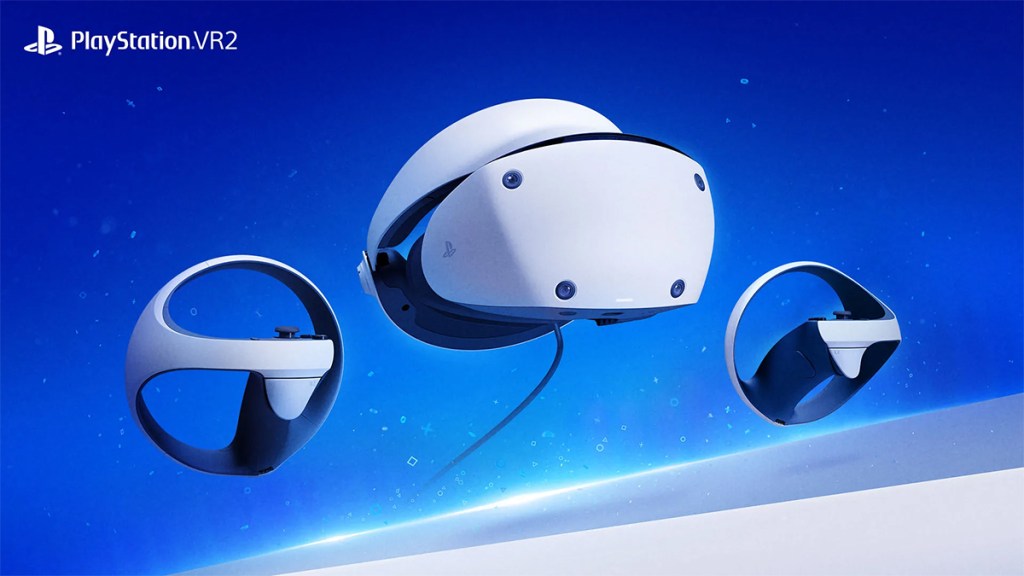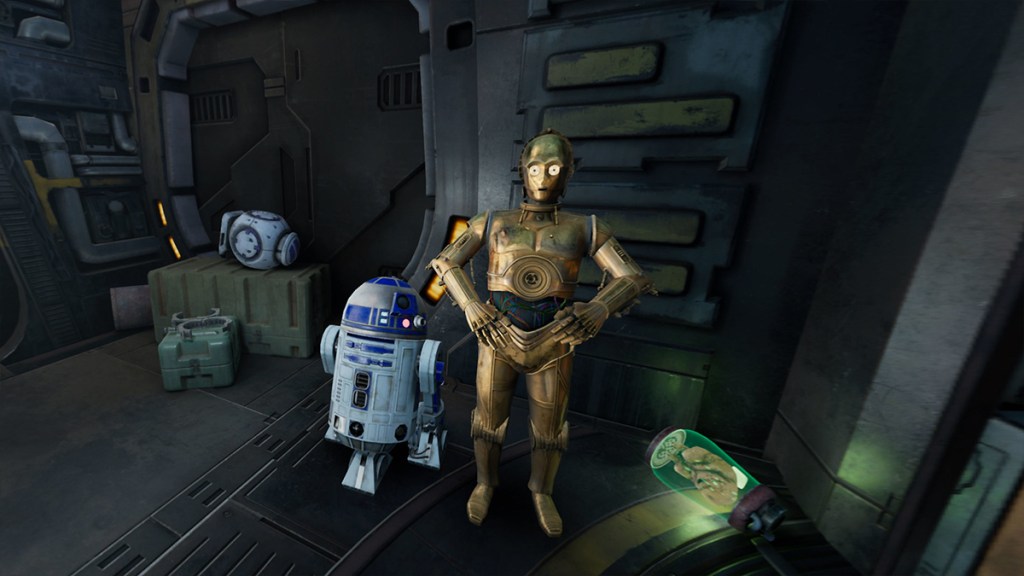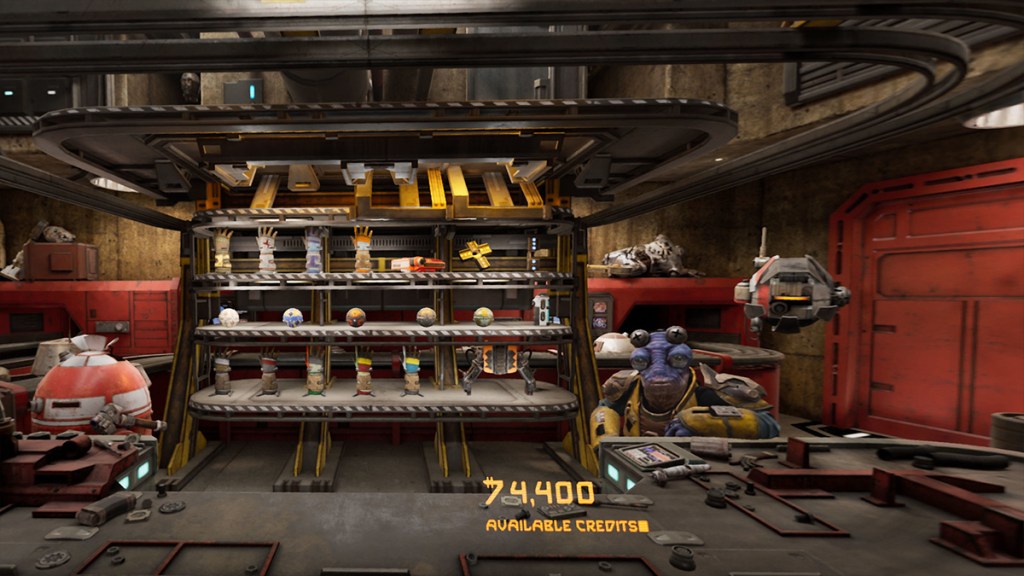Star Wars: Tales from the Galaxy’s Edge – Enhanced Edition is one of the many PlayStation VR2 launch games, as well as one of its several ports. ILMxLab has upgraded the 2020 game to take advantage of the headset’s power and make a more immersive experience. Director Jose Perez III and Producer Harvey Whitney recently sat down with Senior Gaming Editor Michael Leri to speak about what VR does for Star Wars, why it works so well, what the team was proud of, and more.
Michael Leri: Seeing as though the PS VR2 is stronger than both Quest headsets that the game was originally on, how do you go about figuring how to upgrade a previously released game to take advantage of a new system?
Jose Perez III: I think one of the things that’s really great about working at Industrial Light and Magic and ILMxLab is that we have access to some of the best artists in the world. And so when we actually build these assets, even if we’re building it for something that might be a lower-end, as far as the tech side of it goes, headset, we still build the assets at a really high resolution before we bake them down. So what we end up doing here is taking the high-res models and then clean those up and making sure that it is all performant and runs.
And so you actually go through a whole process of taking assets that were super beautiful that you’ve brought down to make them look really good to making them look super beautiful again. It’s a lot of that. Then they rebuilt entire vistas and turned on all the lights. It’s literally a lot more like real-time lighting and dynamic lighting and stuff like that.
Harvey Whitney: What we did early on is as a team, and we’re pretty collaborative at ILMxLab, we all got together and figured out what the hardware was, what it was capable of doing, how we could take it and make this game an enhanced experience that really optimizes what we can do with this hardware. And we took a lot of time just going over all the specifications and what we could and couldn’t do and talked about it as a group and really figured out for certain areas what we really wanted to hit. And we rebuilt these environments, and Jose was being pretty modest about the work, but there was a lot involved to get these to look really great.
And thankfully we do start from something very good to begin with and we went through each environment and each interior space and were like, “How can we really make this shine and what’s the most important thing that we wanna do in this that works within the technical budgets for this hardware?”
Perez III: These little things become a really big deal. Like there’s dynamic lights on all the blaster bolts now. So it doesn’t seem like that big of a deal. It’s like, “Ah, you just threw some lights on the blaster bolt.” But when it’s whipping down a hallway and you see it go by you, there’s a whole new dimension that opens up with it. And so just finding those little things where it’s like, “Oh, just turn that light on! Get some shadows over there!” All of that I think is a big part of it.
Whitney: The lighting on the blaster bolts is a great example of Jose really pushing the team of like, “Hey, this may not seem like much, but once you get it in there, it makes a huge difference.” And we’re all like, “You’re absolutely right.” And so it worked out great, and it’s all those little things add up to make this just visual and audio experience so much better.

And that probably translates to like the specific qualities of the PS VR2 headset.
Perez III: The way the haptics work, we actually attach them a lot to audio and we have such a strong audio team…
Whitney: Skywalker Sound. You may have heard of them. [laughs]
Perez III: It just works. So like when those blaster bolts whip by your head and you feel that little vibration, that’s pretty freaking cool.

ILMxLab has done a lot of things in VR and around VR. Why do you think Star Wars works so well in the VR medium?
Perez III: It’s a fantasy world, right? And so for me when I think about what Star Wars was to me as a kid and growing up and everything, it was so immersive. I’m there. Whether I’m playing with my toys or I’m running around on the playground or I’m watching one of the movies, back then it felt like you were there. And VR is a way to actually go that one extra step where you are inside of it and now your body is a part of this experience where you’re moving and going through that space. It all changes a lot. So for me, it’s a fantasy that, at the moment, is kind of almost best realized in this world because it’s as close as you can get. And I think what’s really cool about it in this specific project is how it connects to Galaxy’s Edge proper.
We keep the real story of that physical space going on in here and those are really connected. So when you go to the park, you also have this memory that that you don’t get the same way with flat experiences when you’re in VR that sticks with you. It’s where you kind of remember being in that place even if you weren’t. So when you have that and then you go to this physical park, there’s this weird moment where you start to go, “Dude, was I already in this place?” And things start to connect in a way that I think is a little weirdly bizarre in a good way.
For me, again, that connection to the real world and to the parks even outside of all this other stuff, there’s something really magical inside of that. And I think the realism that you get in this headset and getting to see this art and stuff at that level, and then going into the actual park and seeing that Dok-Ondar there looks like Dok-Ondar here because we scanned him. It’s really cool. And so I hope that people play this experience having either have gone to Galaxy’s Edge already or play this and then go to Galaxy’s Edge and start to compare and contrast because we did a lot to connect those stories.
Whitney: Early on when I came to ILMxLab, I got into a headset and I had the controller in my hand and I had a lightsaber and I pushed the button and the lightsaber lit up and I’m looking at it and am hearing it. There’s nothing that compares to that, right? It’s not the same on a flat screen. You turn on a lightsaber on a flat screen and it’s cool, but when you’re in VR and you can feel this thing and you see it and you hear, it blew me away. It was one of the best experiences early on when I was at ILMxLab and I was just like, “This is really, really cool.” You’re totally immersed in that and you just can’t do that anywhere else.
It’s just such an involving and engrossing world and just being in it is so much different than being in most other worlds that are not as deep or fantastical as Star Wars.
Perez III: It’s a beautiful IP, right? It’s a real world, but different and you’ve got so many stories in there.

Going back over this game again, you probably see some places you could build on in the future. So what about this experience did you see where you could make some advancements or improvements to any future Star Wars games you could be working on?
Perez III: For this one specifically, the first version of this was kind of a two-part thing. We’ve combined it all into one and the way that it opens up, you don’t have to play all the way through the first part before the second part happens. It all overlaps on top of itself. So the game can expand and there’s more of an opt-in experience. If you start to go out into the wilds and fight Guavian Death Gangs, and you’re like, “I just need to go back and get a drink at the cantina. This is too crazy.” You can do that.
And then from there, all of a sudden Dok-Ondar might show up way early before you’re done. So the world is more open. And that was something that we’re always striving for. We wanted to make it feel like it’s a huge world going on and it’s up to you what you want to get involved in and if you just wanna sit in the cantina and listen to your jukebox, you can do that.
So I think that was a big part of it. Structurally, when you look at something like this and you look and the future, it’s built to tell more stories. So I love the fact that we told this great droid repair person story and that you get the complete droid repair person story here. And if there was ever an opportunity to do more tales, somebody let me know if anybody wants to call me up and do it. [laughs]

It’s such a it’s such a ripe premise to just, like you said, keep going with different tales. If you look at ILMxLab’s history, everything is getting more advanced with every new experience. So Tales from the Galaxy’s Edge seems like it could be a stepping stone to something bigger.
Perez III: What you’re saying is really it. At ILMxLab we don’t say, “Hey, we’re gonna just make a thing because we wanna make some money on it.” We want to tell a meaningful story and we’re looking at the future of storytelling and we want to look at advanced technologies and how we can integrate these technologies to tell new stories. And whether that’s virtual reality, augmented reality, location-based experiences, theme parks, whatever you want to get involved in. We’re looking at what is the weirdest, coolest new stuff that we could tell a story? Like where people are like, “Whoa, this is actually pretty different.” Right now, PS VR2 is that place.
There are cooler things that we could even do inside of this. I think there are lots of things around speech recognition and all kinds of things that could get really interesting. But even just looking out past this, we’re here to make the most immersive, weirdest, connected Star Wars stuff we can. So what’s the weirdest new technology you’ve heard of lately? Let us know. We’ll see if we can do a cool Star Wars on it.
Whitney: Doing bigger and more is definitely not something that we’re worried about. It’s how do we reign it into something that makes sense and we love telling stories and so there’s a lot to be told. So it’s just a matter of what makes sense and when.

And on the opposite side of that, what were you particularly proud of when you went back to it?
Whitney: Some of the work that I think the design team did with Jose working with them closely and taking advantage of all the haptics within the headset and the controller and really tuning that to make it feel really, really good. And each individual weapon feels different and you can tell what you’re doing just by the feel in the haptics. And I think that was one of the things that really went well on this project. And I love how it turned out and Jose may have a different opinion, but that’s really one of the shining moments. We spent a lot of time and energy on that and making sure it really fit. And that was all because of the hardware and what we were capable of doing.
Perez III: For me, you start out playing it and you get the “wow” factor, like, “Whoa, the graphics are better and blah, blah, blah.” And that’s all awesome. It’s all a real plus. But what I was really proud of by the time I played through it again was like, “Oh, we actually told a pretty cool story.” Like when you play through the whole complete thing, there’s this really great story of a found family and what it means to actually be a hero and what it means to actually be a Jedi. And it’s not just about chopping things up. It’s about balance and growth and things that are not just murder.
So when it was all said and done, I looked at the quality of the animation that our team had brought and the quality of the art and getting to see it there with all the lighting and everything, it was all fantastic. And I feel like that we landed the story we went out to tell by the time we got done with it all. So I was really proud of that.

Seeing as though this is a port of a previously released game, are there plans to port Vader Immortal down the line as well?
Whitney: Well, like I said before, we do have a lot of stories that we want to tell, but today we’re only talking about Tales from the Galaxy’s Edge on PS VR2.










